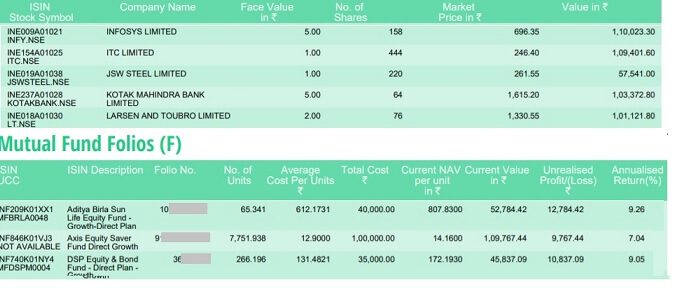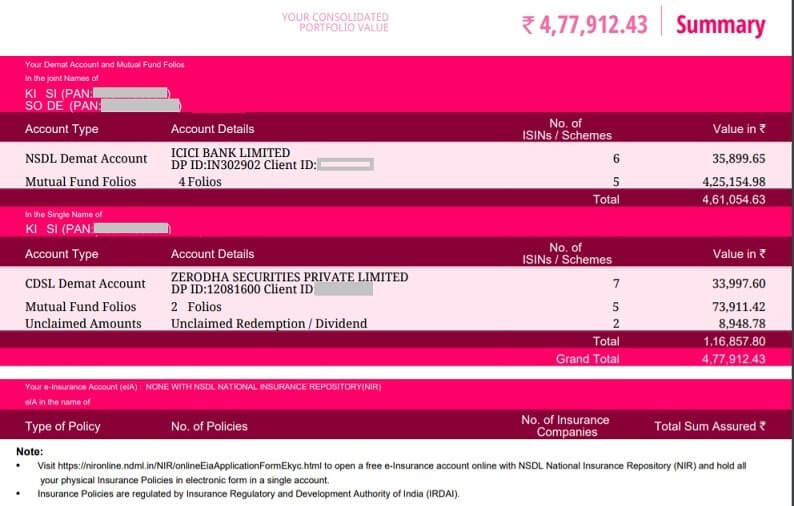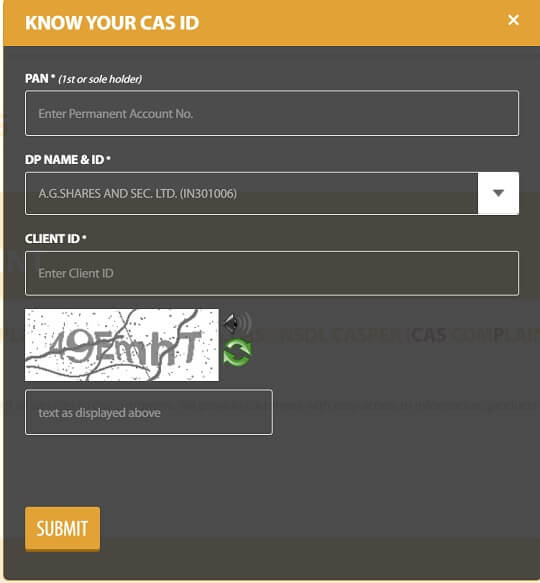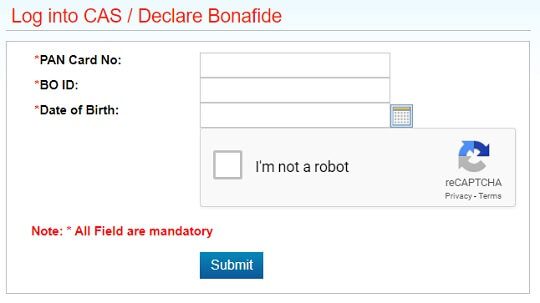CAS, the consolidated account statement, consists of holdings of an investor in Demat accounts held with depository NSDL and/or CDSL, and in units of mutual funds and also a record of transactions. Why does one need CAS? What is a Depository, how is it related to the Stock Exchange and Broker and Demat account number? What is NSDL or CDSL? How to get NSDL and CDSL CAS Statements? The image below shows an excerpt of the NSDL CAS statement for Demat accounts and Mutual Fund Folios. Visit https://nsdlcas.nsdl. com and click on NSDL E-CAS to sign up for this facility. Details later in the article.
Table of Contents
Why does one need CAS?
Investors find it difficult to have a complete picture of their portfolio. Most investors do not readily know the total value of their portfolio or its composition. If you contact your Stockbroker/Mutual Fund AMC then you would receive statement pertaining to just the Demat account or Mutual Fund folio’s maintained by that DP/MF. Unless an investor is well-organised and keeps proper records, he cannot easily compile a list of all his investments.
Karvy Stock Broking Ltd unauthorisedly transferred securities worth ₹2,300 crores of more than 95,000 clients, into its account, by misusing the Power of Attorney(PoA) given by its clients. Details about Karvy transfer and SEBI action are given later in the article. According to the NSE, investors need to ensure that contract notes are received within 24 hours of trades and statement of account at least once in a quarter from the brokers.
When you open a Demat account and buy any shares, your shares are held by these depositories. The depository is similar to a bank, but while a bank holds your money, they hold stocks, shares, bonds etc. There are only two depositories in India – NSDL and CDSL.
If you’re an Investor or Trader who holds positions for more than a day, then it’s a good idea to keep track of your holdings directly in NSDL and CDSL, apart from tracking them Broker’s trading platform.
All you have to do is register on NSDL or CDSL portal and get the login credentials. After that, you can easily track your holdings either on the website or through the mobile apps.
NSDL CAS statement is better than CDSL in terms of presentation and details.
What is CAS?
CAS is a statement consisting of transactions and holdings in investor’s Demat account(s) held with CDSL and NSDL as well as in units of Mutual Funds. CAS includes
- All stock transactions(sell, buy) across Demat accounts which changes the number of shares in Demat account,
- All mutual fund transactions such as New Fund Offer, fresh purchase, additional purchase, redemption, switch in and out, dividend reinvestment, dividend accrued, systemic transactions such as SIP / SWP / STP, bonus, merger, etc.
NSDL CAS is part of the overall vision to enable all financial assets to be held electronically in a single demat account, which was articulated by Finance Minister in his budget speech of July 2014. As a step in this direction, SEBI has introduced this Consolidated Account Statement for all securities assets by consolidating demat accounts and mutual fund folios. NSDL Circular No. NSDL/POLICY/2014/0079 dated July 3, 2014 (Ref. SEBI Circular No. CIR/MRD/DP/21/2014 dated July 1, 2014).
When does one receive CAS?
As per SEBI circular no. CIR/MRD/DP/31/2014 dated November 12, 2014, if there is any transaction in any of the Demat accounts of an investor or in any of his mutual fund folios, then CAS shall be sent to that investor for that month. The image below shows the CDSL CAS statement showing monthly transactions.
If there is no transaction in any of the mutual fund folios and Demat accounts then CAS shall be sent to the investor on half-yearly basis i.e holdings of March and September end will be sent in April and October respectively.
Which Demat accounts and Mutual Funds are in CAS?
All investments held in single or joint names with you as the sole/first holder are a part of your CAS as shown in the image below.
As per SEBI guidelines, the consolidation of account statement is done on the basis of Permanent Account Number (PAN). In the case of joint holders, it is based on the PAN of the first holder and pattern of holding. Based on the PANs provided by the AMCs/MF-RTAs, the Depositories match the PANs available in the Demat account of the clients to determine the common PANs and allocate the PANs among themselves for the purpose of sending CAS. For PANs which are common between Depositories and AMCs, the Depositories send the CAS. In other cases (i.e PANs with no Demat account and only MF units holding), the AMCs/MF-RTAs shall continue to send the CAS.
If an investor has multiple Demat accounts across the depositories which depository will send the CAS to investor?
In case investors have multiple Demat accounts across the two depositories, the depository having the Demat account which has been opened earlier shall be the default depository which will consolidate details across depositories and MF investments and dispatch the CAS to the investor. For example, first I opened Demat account in ICICIDirect.com which is associated with NSDL and later opened an account with Zerodha which is associated with CDSL. So I get CAS statement from NSDL and not from CDSL.
To ensure receipt of CAS by email the investor should update his email id with his Depository Participant (DP) along with consent for receiving transaction statements by email.
The investor can request for change of default depository to receive the CAS by informing the Depository Participant (DP) of the default depository from whom he is receiving the CAS. NSDL CAS statement is better than CDSL.
About NSDL and CDSL
What is a depository? What are NSDL and CDSL?
The depository is an organization which holds financial securities with it in DeMat form i.e electronic form. The depository is similar to a bank, but while a bank holds your money, they hold stocks, shares, bonds etc. It is responsible for maintenance of ownership records and facilitation of trading in dematerialised securities. There are only two depositories in India – NSDL and CDSL. When you open a Demat account and buy any shares, your shares are held by these depositories. Moreover, when a company needs to know its shareholder detail to send dividend, rights or for any other notification, it can ask for the information from these two depositories in India. Even you can open an account with two DP’s and you can transfer the share from NSDL to CSDL and vice versa
- National Securities Depository Limited (NSDL) which is promoted by the National Stock Exchange, Industrial Development Bank of India and Unit Trust of India among others. For CAS NSDL website is https://nsdlcas.nsdl.com/
- Central Depository Services Limited (CDSL) which is promoted by the Bombay Stock Exchange, State Bank of India, Bank of India among others. Its website is https://www.cdslindia.com/
Depository interacts with its clients or investors through its agents, called Depository Participants popularly called DPs. For any investor to avail, the services provided by the Depository has to open Depository account, known as Demat Account, with any of the DPs. A DP can be a bank, financial institution, brokerage house, or similar entity. To be eligible, it must be registered with the Securities and Exchange Board of India (SEBI) and comply with its norms and guidelines. The image below shows the interaction between investors(buying/selling stocks), Exchange, Depository and Depository Participant(DP)
You can’t directly choose which depository to open an account. It is the broker or the Depository Participant (DP) how decides on it.
Demat Account Number, DP Id and Customer Id
A Demat account number is a combination of the DP ID and the customer ID of the Demat account holder. Usually, the first 8-digits of your Demat account number is your DP ID where the last 8-digits of your Demat account number is the Customer ID of the account holder. For NSDL, the Demat account number starts with “IN” followed by a 14-digit numeric code.
For example,
- For CDSL, if your Demat account number is 0101010102020202, in such a case 01010101 is the DP ID and 0202020202 is the Demat account holder’s customer ID. The Demat account number is also known as Beneficiary Owner ID or BO ID in the case of the CDSL
- For NSDL, if a Demat account number is IN12345698765432, in that case, IN123456 is the DP ID and 98765432 is the customer ID of the Demat account holder.
Know more about NSDL and CDSL
To know more & for any further query regarding NSDL CAS, visit https://nsdlcas.nsdl.com . You can also call at 1800222990 (Toll Free Number) or write at NSDL, 4th Floor, ‘A’ Wing, Trade World, Kamala Mills Compound, Senapati Bapat Marg, Lower Parel, Mumbai – 400 013.
Karvy Stock Broking pledging client’s shares
On 22 Nov 2019, SEBI banned Karvy Stock Broking Ltd from running its operations for misusing the money and pledging the securities belonging to its clients. According to the SEBI order,
- Karvy had pledged securities worth Rs 2,300 crore of over 95,000 clients with ICICI Bank, HDFC Bank, IndusInd Bank and Bajaj Finance as collateral to raise over Rs 600 crore in loans. It misused the Power of Attorney(PoA) given by its clients
- The broker transferred this money to its group company, Karvy Realty Private Limited
Karvy has 1.2 million clients, of whom around 300,000 are active
By 3 Dec 2019, on SEBI directive, share depositories transferred securities worth Rs 2,013.77 crore to 82,559 clients of Karvy. This represents 87% of the impacted clients. The shares returned included those that were paid for by the clients but had been unlawfully pledged by misusing their power of attorney.
The Sebi directive has spooked lenders, who are gearing up for a legal battle. Bajaj Finance was the first to get moving with its plea in SAT. Other lenders such as ICICI Bank, HDFC Bank and IndusInd Bank are expected to approach SAT soon.
If you’re an Investor or Trader who hold positions for more than a day, then it’s a good idea to keep track of your holdings directly in NSDL and CDSL, apart from tracking them Broker’s trading platform.
How to register for NSDL CAS?
Visit https://nsdlcas.nsdl. com and click on NSDL E-CAS to sign up for this facility.
- Enter Your 9 digit CAS ID. If you don’t know the CAS Id, you can use the service ‘know your cas id’ which is available in the E-Cas section. Click Know Your Cas Id button.
- Enter Your valid 10 digit PAN Number
- Enter the captcha code shown below
- Click Submit Button
- Enter Your PAN Number
- Select Your DP NAME & ID (Eg : A.G.Shares & Sec Ltd (IN301006)
- Enter your Client ID (Eg : 87654321)
- Enter Captcha code shown below
- Click Submit Button
How to register for CDSL CAS?
The investor can download the CAS statements dispatched to him by CDSL from the ‘CAS’ tab available on CDSL website, www.cdslindia.com. Go to https://www.cdslindia.com/cas/
- For CDSL, if your Demat account number is 0101010102020202, in such a case 01010101 is the DP ID and 0202020202 is the Demat account holder’s customer ID. The Demat account number is also known as Beneficiary Owner ID or BO ID in the case of the CDSL
What does NSDL CAS look like?
NSDL CAS enriches investor experience of managing his portfolio effectively because of
- Graphical representation
- A complete summary of all the holdings in Demat and Mutual Funds
- Portfolio classification as per different asset class
What does CDSL CAS look like?
CDLS does not look flashy as NSDL and it provides information on all the holdings in Demat and Mutual Funds. The image below shows the CDSL CAS statement showing Mutual Funds Holdings. It does not show Folio Number which is available in NSDL CAS. Our article What is Folio Number in Mutual Funds? explains the Folio number. An ISIN code is a 12-digit alphanumeric number that is used to identify specific securities ex: share or mutual fund.
What is ISIN Code?
In CAS statements details about Mutual fund or stock are in terms of ISIN number.
An ISIN code is a 12-digit alphanumeric number that is used to identify specific securities ex: share or mutual fund. For example, ISIN number of Reliance is INE002A01018 while ISIN of Microsoft which is a US-based company is US594918104. ISIN number is broken down:
- First two letters of the ISIN code refer to the country in which the issuing company is based out of. Ex for India it will be IN.
- The next nine digits identify specific security and act as a unique identifier.
- The final character also referred to as the ‘check digit’ checks forgery.
Overview of ISIN number
- An ISIN is a code that uniquely identifies a specific securities issue.
- The numbers are allocated by a country’s respective national numbering agency (NNA).
- An ISIN is not the same as the ticker symbol, which identifies the stock at the exchange level. The ISIN is a number assigned to a security that is universally recognizable.
- ISINs are used for numerous reasons including clearing and settlement. The numbers ensure a consistent format so that holdings of institutional investors can be tracked consistent across markets worldwide.
In India, the task of issuing ISIN for various securities has been assigned by the Securities and Exchange Board of India (SEBI) to the National Securities Depository Limited (NSDL). For the government securities, the allotment of the ISIN code is regulated by the Reserve Bank of India (RBI).
The NSDL was established in August 1996, under the aegis of the Depositories Act, 1996. You can use the NSDL website to look up and verify ISIN codes.
Related Articles:
- What is Folio Number in Mutual Funds?
- All About Mutual Funds : Basics, Choosing, Paperwork, Direct Investing
- Investing in Equities: Stocks vs Mutual Funds












We have more then 10 Demat a/cs of our family members in two depositories of NSDL, email add. in corresponding a/cs are updated separately. Pls. suggest How can I take all the reports(holding,transactions etc.) of entire a/c from a single window bcoz. i have to maintained all the a/c for the accounting & taxation purpose.
Sir, I want know my stock as on 12/05/20 to my complete transactions and also know my exact mutual fund folios.
My email address is, das1234jk@gmail.com, request to furnish by mail please.
Thanks.
Please follow the steps mentioned in the article
All you have to do is register on NSDL or CDSL portal and get the login credentials. After that, you can easily track your holdings either on the website or through the mobile apps. Steps explained in the article
Sir,
i want to print my stock holding as on 31/03/2020 to comply with my transactions and know my exact holding. for my record purpose.
Request to inform sight to enable me to find my statement required.
my e mail address is ‘ adanikaushik@gmail.com‘ request to furnish by mail or inform sight to obtain the same.
thanks